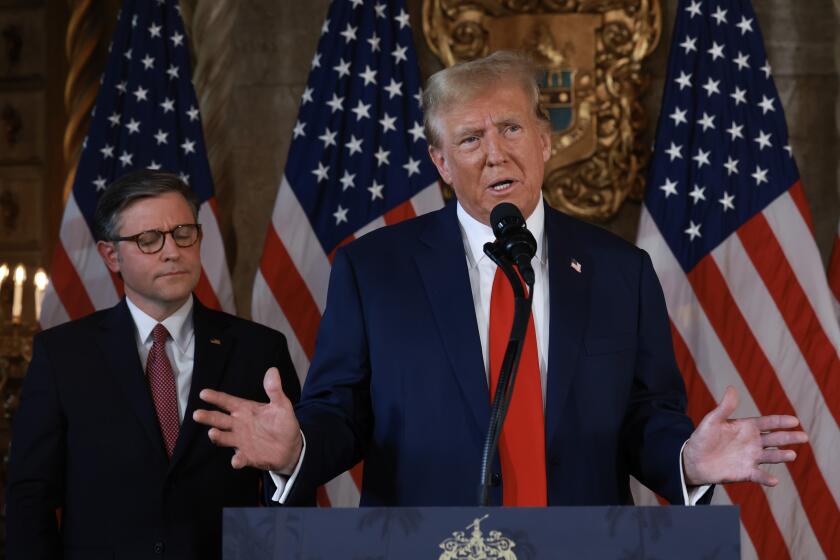Column: Trump’s budget cutters have set themselves up to fail

- Share via
President-elect Donald Trump’s designated debt-busters, Elon Musk and Vivek Ramaswamy, last week wrote an op-ed in the Wall Street Journal providing the fullest accounting yet of their plans to cut “waste, fraud and abuse” — that most well-worn and oft-broken of political promises.
Opinion Columnist
Jackie Calmes
Jackie Calmes brings a critical eye to the national political scene. She has decades of experience covering the White House and Congress.
Indeed, an omission from the dynamic duo’s piece suggests that they — and Trump — may have already trimmed their ambitions: Musk and Ramaswamy made no mention of Musk’s previous boasts that he’d slash “at least” $2 trillion in a single year from the federal budget.
It’s a wonder that the aspiring oligarch and “super genius,” as Trump calls him, made the outlandish claim in the first place, including at Trump’s infamous preelection rally at Madison Square Garden. Perhaps he’s finally been schooled on the realities of fiscal policy.
More than two weeks into Trump’s transition, we know what he wants Musk to do come January, but Vance, the supposed future of MAGA, not so much.
Yet neither did Musk and Ramaswamy disavow the $2-trillion promise. So it’s worth examining just why the goal is a mission impossible, and why the actions they say Trump will take are unlikely to significantly reduce federal debt. In fact, if we subtract Trump’s promised tax cuts from the projected revenue, annual deficits and the debt could well increase — just as they did during his first term, when his actions caused the national debt to balloon by $8.4 trillion over a decade.
A little fiscal math: The federal budget for the fiscal year that began Oct. 1 is $6.8 trillion. Musk proposed to cut 30% of that. Which would be hard enough if the whole amount were on the chopping block. But roughly three-quarters of the $6.8 trillion is either politically untouchable (especially Medicare and Social Security, which Trump has vowed to leave unscathed) or legally off-limits (interest on the debt).
Donald Trump will meet little resistance from the branches of government he shaped starting in 2017.
That leaves just over a quarter of federal spending: $1.9 trillion in so-called “discretionary spending” that Congress controls annually through its budget process. But discretionary programs account for just about everything that the government does and that Americans expect it to do — including domestic spending and funding the military.
A few examples: air traffic control, agriculture programs, disaster aid, education, courts, highways and other infrastructure, immigration, homeland security, law enforcement, national parks, the Pentagon and scientific research. (For those America First-ers who like to trash foreign aid: It’s less than 1% of spending, not the roughly 25% that many Americans tell pollsters they think it is.)
In short, Musk’s aim to cut $2 trillion would require wiping out not just supposed waste, fraud and abuse but also all discretionary spending — even though Trump has said he wants to increase the defense portion. And still the cuts would come up short. Musk conceded “temporary hardship” would result, but Bloomberg News wrote that slashing so much “would require a level of austerity unprecedented since the winding down of World War II.” That’s probably an understatement.
And consider this: Discretionary spending has been at “historic lows” as a share of the budget, according to the nonpartisan Congressional Budget Office. That’s because it’s the piece of the federal pie that always gets sliced up whenever presidents and Congresses do whittle spending. Meanwhile, expenditures for health and retirement benefits for aging baby boomers are growing fast, as is interest on borrowing. Together with tax cuts, these drive up the debt.
Another perspective: Contrary to claims from Presidents Reagan, George W. Bush and Trump, tax cuts do not pay for themselves by spurring economic activity. Extending Trump’s first-term tax cuts, as he’s promised, would add about $4 trillion to the debt over 10 years. (By contrast, much discretionary spending — for instance, on infrastructure, education and research — actually does bring economic benefits; it’s considered the “seed corn” for the nation’s physical and human capital.)
The current year-end budget follies give a small glimpse into just how hard budget-cutting is. Congress is tussling as usual over farm spending, while considering an unanticipated expense — nearly $100 billion — for disaster aid after Hurricanes Helene and Milton.
Skeptics be damned, Musk and Ramaswamy say.
They’ll “cut the federal government down to size.” What size, you ask? They don’t say. For a half-century, no matter which party held power, annual federal spending has been about 21% of the size of the nation’s economy, the gross domestic product. And tax revenue has been roughly 17% of GDP. Hence yearly deficits and a growing debt.
The consistency of annual spending levels across decades and parties shows that Americans seem to want a government of roughly that size. Spending in 2024 is nearly 24% of GDP. There’s room to cut, just not by $2 trillion.
Musk and Ramaswamy also didn’t identify specifically what they’d cut, aside from three perennial conservative targets — Planned Parenthood, public broadcasting and foreign aid — that together add up to $2.3 billion, hardly even a rounding error relative to annual deficits. They broadly take aim at more than $500 billion in annual spending for programs that Congress hasn’t reauthorized formally. But big-ticket items in that category include veterans’ health programs, NASA and homeland security. Don’t hold your breath for those cuts.
They contend that Trump would simply impound funds that Congress appropriates but he doesn’t want. Well, that’s illegal under the Nixon-era 1974 Impoundment Control Act. The law has stood the legal and political tests of 50 years’ time, but no matter, the Trump advisors wrote: “The current Supreme Court would likely side with” Trump. Maybe so, maybe not.
Musk and Ramaswamy wrote more in their op-ed about cutting federal regulations than cutting spending. Repealing rules would allow for cost-saving “mass” firings in the government bureaucracy, they argued. But conservative economist Brian Riedl, a fellow at the Manhattan Institute, calculated that even large workforce reductions wouldn’t meaningfully pare the budget. And, he said, the government would likely end up hiring private contractors for some functions.
In sum, as we say in math exercises, Trump’s numbers won’t add up to reduced deficits and smaller government. Again.
More to Read
Get the latest from Jackie Calmes
Commentary on politics and more from award-winning opinion columnist.
You may occasionally receive promotional content from the Los Angeles Times.














